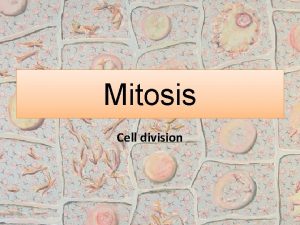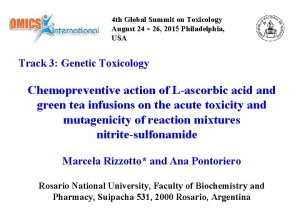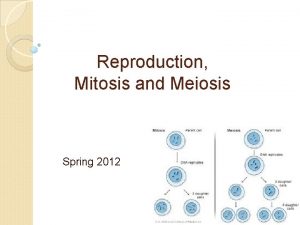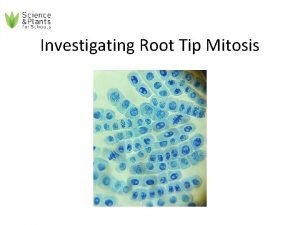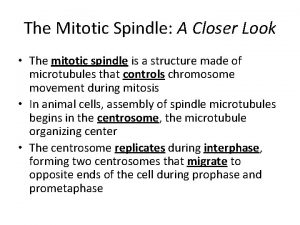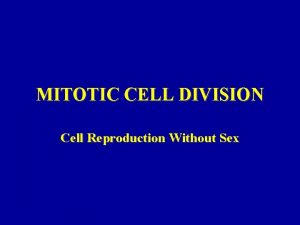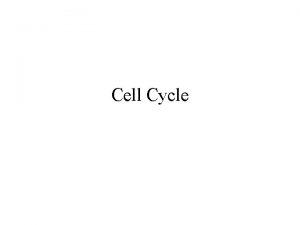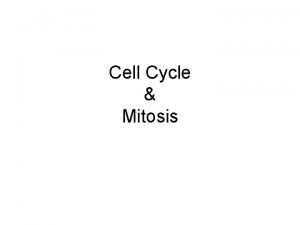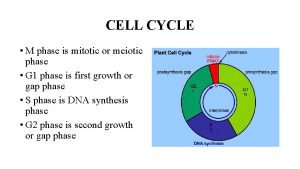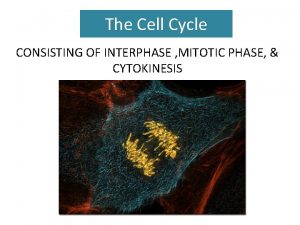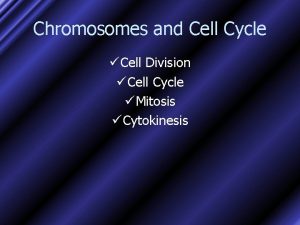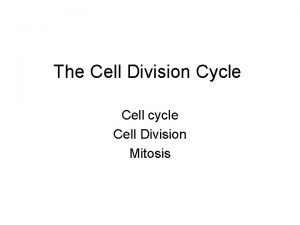The cell cycle Mitotic cycle time Tc cell




























- Slides: 28


The cell cycle Mitotic cycle time (Tc) = cell cycle time = time between successive divisions


Autoradiography 自動放射顯影


Bromodeoxyuridine (Brd. Urd)

Two advantages in Brd. Urd over autoradiography 1. Not involve radioactive material 2. Shorten the time for result

1. The relative length of different cell cycle phase vary in different cell types 2. Human cells of Tc > Hamster cells of Tc 3. S> G 2 > M


Synchronously Dividing cell cultures 同步化 Definition: All of the cells occupy the same phase of the cell cycle at a given time. Techniques for synchrony: 1. Mitotic harvest [shake off] 2. Drug [e. g. , hydroxyurea] <1> S phase cells are killed <2> Block at the end of G 1


Most population in mitosis

Irradiated at various times afterward, Corresponding to different cell cycle phase

Cell cycle phase & radiosensitivity shoulder

Early G 1 later G 1 The pattern cannot be distinguished in hamster cells because G 1 is too short.

1. Pattern similar 2. Important difference

Summary of radiosensitivity with cell age in the mitotic cycle 1. Cells are most sensitive at or close to mitosis 2. Resistance is usually greatest in later S phase 3. Resistance at early G 1 & sensitivity at later G 1 4. G 2 phase is usually sensitive, perhaps as M phase

Molecular checkpoint genes


細胞流速分析儀 Flow cytometer

Cell number Flow cytometer & separation of cell cycle phase G 0 /G 1 M 2 N 4 N DNA content

The effect of oxygen at various phases of the cell cycle The ratio of hypoxic to aerated doses needed to achieve the same biological effect is called OER. Survival Oxygen enhancement ratio (OER) ch 6 OER S (2. 3 -2. 4) < G 1 & G 2 OER varies significantly through the cycle. hypoxic aerated Dose (Gy)

The age-response function for a tissue in vivo Variation of sensitivity with cell age for neutrons CPM = count per min 1. The variation of thymidine uptake with time. 2. First wave = DNA synthesis period 3. Correlated to max resistance to x-ray

The in vivo pattern of response as a function of cell age is similar to g-ray and neutrons, with max resistance occurring in later S phase for in vitro culture cells.

Mechanism for the age-response function 1. DNA amount or form 2. Naturally occuring sulfhydryl compounds

The possible implications of the age-response function in radiotherapy Dose at Asynchronous cell population S phase remained synchronize cell cycle move Dose later at sensitive phase sensitizing called Sensitization due to reassortment


 What is a mitotic index
What is a mitotic index Hayflick limit
Hayflick limit Significane of mitosis
Significane of mitosis Mitotic index
Mitotic index Mitotic zone
Mitotic zone Mitotic phase
Mitotic phase Mitotic meaning
Mitotic meaning Mitotic index formula
Mitotic index formula Igcse
Igcse Start time end time and elapsed time
Start time end time and elapsed time Cell cycle and cell division
Cell cycle and cell division Cell cycle and cell division
Cell cycle and cell division Biology.arizona.edu/cell bio/activities/cell cycle/01.html
Biology.arizona.edu/cell bio/activities/cell cycle/01.html Cell cycle phases in order
Cell cycle phases in order Takt time vs cycle time
Takt time vs cycle time Hát kết hợp bộ gõ cơ thể
Hát kết hợp bộ gõ cơ thể Bổ thể
Bổ thể Tỉ lệ cơ thể trẻ em
Tỉ lệ cơ thể trẻ em Chó sói
Chó sói Glasgow thang điểm
Glasgow thang điểm Chúa yêu trần thế
Chúa yêu trần thế Môn thể thao bắt đầu bằng chữ đua
Môn thể thao bắt đầu bằng chữ đua Thế nào là hệ số cao nhất
Thế nào là hệ số cao nhất Các châu lục và đại dương trên thế giới
Các châu lục và đại dương trên thế giới Công của trọng lực
Công của trọng lực Trời xanh đây là của chúng ta thể thơ
Trời xanh đây là của chúng ta thể thơ Mật thư anh em như thể tay chân
Mật thư anh em như thể tay chân Làm thế nào để 102-1=99
Làm thế nào để 102-1=99



